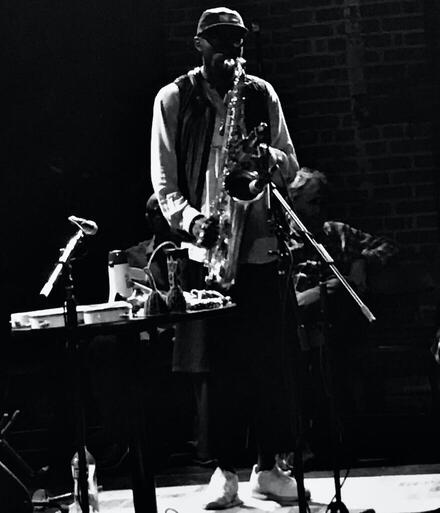William Parker lugged the biggest standup bass you've ever seen all the way from New York, and made its every pore sweat like Gethsemane. He wanted to make sure we got a feel for the tradition of the late avant drummer Milford Graves, for whose wide-ranging art exhibit at ICA LA Parker's concert served as a closing event.
William Hooker, the drummer in Hooker's trio, showed few direct commonalities with the way Graves stirred the soup behind Albert Ayler, Bill Dixon and Don Pullen, other than a need for freedom and a long dedication to his path. Isaiah Collier, the tall young tenor saxophonist, had become a prodigious force on the Chicago scene and recently visited Los Angeles with his duo I Am.
Expressionless in dark drapes of African-inspired vest and pants, Collier set himself up facing colorfully pajamaed Parker, so he could pick up visual as well as auditory cues from the veteran. Between them, and a bit in back, shave-headed Hooker seemed as if he just pulled the sounds of the other two through his ears and into his heart to produce spontaneous condensations and interpretations through his sticks and feet; his decades of collaboration with Parker precluded any need for eye contact with the bassman.
Well, we all could certainly feel Parker. Whether he traveled around the bass's neck, plucked a hypnotic monotone or bowed way up by the scroll, each note seemed to contain three or four -- he's one of the few bassists who can pull off extended solo performances, because he's an orchestra. Parker was passionate, but not so much emotional as caught up in an earth ritual that transcended the trivialities of daily life. Encountering problems with his amplification, he slowed down from the rapt intensity of the extended opening segment and let us all breathe, before picking up a ghaita (the double-reed oboelike instrument often used by the Master Musicians of Jajouka) and plunging into an elevational healing duet with Collier that vibrated all our cells. He returned to the bass to close the first set with classic avant turmoil.
Like Parker, Hooker doesn't visit L.A. often. Last time we caught him was at Spaceland decades ago; he left the impression of hitting so hard that any drinks on stageside tables risked spillage. A different angle this time revealed that those devastating whaps on his tiny kit, often accompanied by cathartic shouts, were a small component of a technique that included subtle paradiddles, rimshots, enveloping cymbal work, dynamic malletry, and a jolting but rhythmically effective foot. He did use big sticks, though, and what a bucking-bronco team he made with Parker!
Collier was a revelation. In the context of extended tenor free blowing, he jumped the first hurdle by somehow not sounding like John Coltrane, Albert Ayler or David S. Ware. At the outset, he poured forth unlimited streams of intervallic jumps from top to bottom of his horn that defined a beat in ways neither of his trio mates was attempting, but that complemented their tangle excellently, his tone unusually clean and reminiscent of his silver instrument. Collier moved on to exhibit command of overblowing and especially some birdlike sidekey trilling methods unique to himself, and that's saying something. For even more variety, he had a little side table with a few bells and such. Parker and Hooker clearly dug the interaction almost as much as he did.
Fire, earth, water -- this set had it all. The full house (second of two nights) were nodding heads as if experiencing Atman. At least one younger guy had come all the way from Arizona just for this, and he'd been here the night before too. Since the death of Coltrane in 1967, free jazz has been written off at least once every decade, especially in Los Angeles. Yank the obituary one more time.
* * *
See images of Milford Graves' Institute of Contemporary Art exhibit here.
PHOTO OF ISAIAH COLLIER BY DEBI DOORZ.

